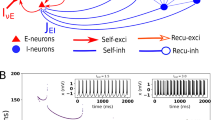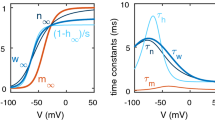Abstract
We study an excitatory all-to-all coupled network of N spiking neurons with synaptically filtered background noise and slow activity-dependent hyperpolarization currents. Such a system exhibits noise-induced burst oscillations over a range of values of the noise strength (variance) and level of cell excitability. Since both of these quantities depend on the rate of background synaptic inputs, we show how noise can provide a mechanism for increasing the robustness of rhythmic bursting and the range of burst frequencies. By exploiting a separation of time scales we also show how the system dynamics can be reduced to low-dimensional mean field equations in the limit N → ∞. Analysis of the bifurcation structure of the mean field equations provides insights into the dynamical mechanisms for initiating and terminating the bursts.
















Similar content being viewed by others
References
Brockhaus, J., & Ballanyi, K. (1998). Synaptic inhibition in the isolated respiratory network of neonatal rats. European Journal of Neuroscience, 10, 3823–3839.
Butera, R. J., Rinzel, J., & Smith, J. C. (1999a). Models of respiratory rthythm generation in the pre-bötzinger complex. I. bursting pacemaker neurons. Journal of Neurophysiology, 81, 382–397.
Butera, R. J., Rinzel, J., & Smith, J. C. (1999b). Models of respiratory rthythm generation in the pre-bötzinger complex. II. Populations of coupled pacemaker neurons. Journal of Neurophysiology, 81, 398–415.
Buzaki, G. (2007). Rhythms in the brain. Oxford: Oxford University Press.
Chub, N., & O’Donovan, M. J. (2001). Post-episode depression of GABAergic transmission in spinal neurons of the chick embryo. Journal of Neurophysiology, 85, 2166–2176.
Cupello, A. (2003). Neuronal transmembrane chloride electrochemical gradient: A key player in GABAA receptor activation physiological effect. Amino Acids, 24, 335–346.
Del Negro, C. A., Johnson, S. M., Butera, R. J., & Smith, J. C. (2001). Models of respiratory rthythm generation in the pre-bötzinger complex. III. Experimental tests of model predictions. Journal of Neurophysiology, 86, 59–74.
Del Negro, C. A., Morgado-Valle, C., & Feldman, J. L. (2002). Respiratory rhythm: An emergent network property? Neuron, 34, 821–830.
Destexhe, A., Rudolph, M., Fellous, J. M., & Sejnowski, T. J. (2001). Fluctuating synaptic conductances recreate in vivo-like activity in neocortical neurons. Neuroscience, 107, 13–24.
Feldman, J. L., & Del Negro, C. A. (2006). Looking for inspiration: New perspectives on respiratory rhythm. Naturalist Reviews in Neuroscience, 7, 232–242, March.
Funk, G. D., & Feldman, J. L. (1995). Generation of respiratory rhythm and pattern in mammals: Insights from developmental studies. Current Opinion in Neurobiology, 5, 778–785.
Gang, H., Ditzinger, T., Ning, C. Z., & Haken, H. (1993). Stochastic resonance without external periodic force. Physical Review Letters, 71, 807–810.
Gardiner, C. W. (2004). Handbook of stochastic methods. New York: Springer.
Ge, Q., & Feldman, J. L. (1998). AMPA receptor activation and phosphatase inhibition affect neonatal rat respiratory rhythm generation. Journal of Physiology, 509, 255–266.
Gigante, G., Mattia, M., & Giudice, P. D. (2007). Diverse population-bursting modes of adapting spiking neurons. Physical Review Letters, 98, 148101.
Gutkin, B. S., Ermentrout, B. G. (1998). Dynamics of membrane excitability determine inter-spike interval variability: A link between spike generation mechanisms and cortical spike train statistics. Neural Computation, 10, 1047–1065.
Han, S. K., Yim, T. G., Postnov, D. E., & Sosnovtseva, O. V. (1999). Interacting coherence resonance oscillators. Physical Review Letters, 83, 1771.
Hille, B. (2001). Ion channels of excitable membranes, 3rd edition. Sunderland, MA: Sinauer.
Holcman, D., & Tsodyks, M. (2006). The emergence of up and down states in cortical networks. PLoS Computational Biology, 2(3), 0714–0181.
Izhikevich, E. M. (2007). Dynamical systems in Neuroscience: The geometry of excitability and bursting. Cambridge: MIT.
Johnson, S. M., Wilkerson, J. E., Wenninger, M. R., Henderson, D. R., & Mitchell, G. S. (2002). Role of synaptic inhibition in turtle respiratory rhythm generation. Journal of Physiology, 544, 253–265.
Jonas, E., & Kaczmarek, L. K. (1999). The inside story: Subcellular mechanisms of neuromodulation. In P. S. Katz (Ed.), Beyond neurotransmission: Neuromodulation and its importance for information processing (pp. 83–120). Oxford: Oxford University Press.
Kosmidis, E. K., Pierrefiche, O., & Vibert, J. F. (2004). Respiratory-like rhythmic activity can be produced by an excitatory network of non-pacemaker neuron models. Journal of Neurophysiology, 92, 686–699.
Kurrer, C., & Schulten, K. (1995). Noise-induced synchronous neural oscillations. Physical Review E, 51, 6213.
Kuznetsov, Y. A. (2004). Elements of Applied Bifurcation Theory, 3rd edition. New York: Springer-Verlag.
Lindner, B., Garcia-Ojalvo, J., Neiman, A., & Schimansky-Geier, L. (2004). Effects of noise in excitable systems. Physics Reports, 392, 321–424.
Loebel, A., & Tsodyks, M. (2002). Computation by ensemble synchronization in recurrent networks with synaptic depression. Journal of Comparative Neuroscience, 13, 111–124.
Mattia, M., & Giudice, P. D. (2002). Population dynamics of interacting spiking neurons. Physical Review E, 66, 051917.
McCormick, D. A., & Yuste, R. (2006). Up states and cortical dynamics. In G. Grillner (Ed.), Microcircuits: The interface between neurons and global brain function. Cambridge: MIT.
O’Donovan, M. J. (1999). The origin of spontaneous activity in developing networks of the vertebrate nervous system. Current Opinion in Neurobiology, 9, 94–104.
Pace, R. W., Mackay, D. D., Feldman, J. L., & Del Negro, C. A. (2007). Role of persistent sodium current in mouse preBötzinger complex neurons and respiratory rhythm generation. Journal of Physiology, 582, 485–496.
Pham, J., Pakdaman, K., & Vibert, J. F. (1998). Noise-induced coherent oscillations in randomly connected neural networks. Physical Review E, 58, 3610.
Pikovisky, A., & Ruffo, S. (1999). Finite-size effects in a population of interacting oscillators. Physical Review E, 59, 1633.
Pradines, J. R., Osipov, G. V., & Collins, J. J. (1999). Coherence resonance in excitable and oscilatory systems: The essential role of slow and fast dynamics. Physical Review E, 60, 6407.
Rappel, W. J., & Karma, A. (1996). Noise-induced coherence in neural networks. Physical Review Letters, 77, 3256.
Rappel, W. J., & Strogatz, S. (1994). Stochastic resonance in an autonomous system with a nonuniform limit cycle. Physical Review E, 50, 3249–3250.
Rinzel, J., & Ermentrout, B. (1998). Analysis of neural excitability and oscillations. In C. Koch, I. Segev (Eds.), Methods of neuronal modeling: From synapses to networks, 2nd Ed. (pp. 252–291). Cambridge: Bradford.
Sernagor, E., Chub, N., Ritter, A., & O’Donovan, M. J. (1995). Pharmacological characterization of the rhythmic synaptic drive onto lumbosacral motoneurons in the chick embryo spinal cord. Journal of Neuroscience, 15, 7452–7464.
Shelly, M. J., & Tao, L. (2001). Effidient and accurate time-stepping schemes for integrate-and-fire neuronal networks. Journal of Comparative Neuroscience, 11, 11–119.
Smith, J. C., Ellenberger, H. H., Ballanyi, K., Richter, D. W., & Feldman, J. L. (1991). Pre-Bötzinger complex: A brainstem region that may generate respiratory rhythm in mammals. Science, 254, 726–729.
Tabak, J., O’Donovan, M. J., Rinzel, J. (2006). Differential control of active and silent phases in relaxation models of neuronal rhythms. Journal of Comparative Neuroscience, 21, 307–328.
Tabak, J., & Rinzel, J. (2005). Bursting in excitatory neural networks. In S. Coombes & P. C. Bressloff (Eds.), Bursting: The genesis of rhythm in the nervous system (pp. 273–301). Hackensack: World Scientific.
Tabak, J., Rinzel, J., & O’Donovan, J. (2001). The role of activity-dependent network depression in the expression and self-regulation of spontaneous activity in the developing spinal cord. Journal of Neuroscience, 21, 8966–8978.
Tabak, J., Senn, W., O’Donovan, J., & Rinzel, J. (2000). Modeling of spontaneous activity in developing spinal cord using activity-dependent depression in an excitatory network. Journal of Neuroscience, 20, 3041–3056.
Tryba, A. K., Peña, F., & Ramirez, J. M. (2003). Stabilization of bursting in respiratory pacemaker neurons. Journal of Neuroscience, 23, 3538–3546.
Tsodyks, M., Uziel, A., & Markram, H. (2000). Synchrony generation in recurrent networks with frequency-dependent synapses. Journal of Neuroscience, 20, RC50.
Van Vreeswijk, C., & Hansel, D. (2001). Patterns of synchrony in neural networks with spike adaptation. Neural Computation, 13, 959–992.
Vladimirski, B. B., Tabak, J., O’Donovan, M. J., & Rinzel, J. (in press). Episodic activity in a heterogenious excitatory network, from spiking neurons to mean field. Journal of Comparative Neuroscience.
Wilson, H. R., & Cowan, J. D. (1972). Excitatory and inhibitory interactions in localized populations of model neurons. Biophysical Journal, 12, 1–22.
Acknowledgements
This work was supported by the NSF (DMS 0515725 and RTG 0354259). The authors would also like to thank Christopher Del Negro and Peter Roper for their helpful suggestions and comments.
Author information
Authors and Affiliations
Additional information
Action Editor: Misha Tsodyks
An erratum to this article is available at http://dx.doi.org/10.1007/s10827-008-0114-6.
Rights and permissions
About this article
Cite this article
Nesse, W.H., Borisyuk, A. & Bressloff, P.C. Fluctuation-driven rhythmogenesis in an excitatory neuronal network with slow adaptation. J Comput Neurosci 25, 317–333 (2008). https://doi.org/10.1007/s10827-008-0081-y
Received:
Revised:
Accepted:
Published:
Issue Date:
DOI: https://doi.org/10.1007/s10827-008-0081-y




